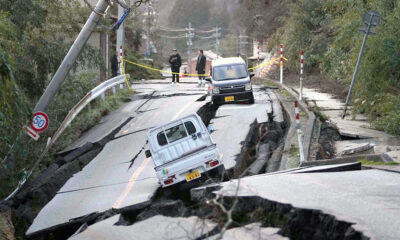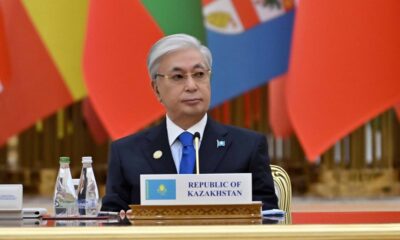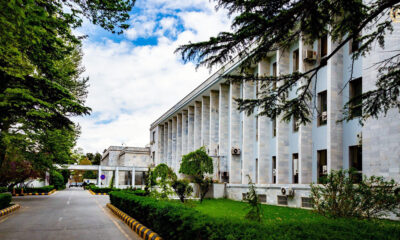Science & Technology
Study documents headaches experienced by astronauts in space

Research in the expanding field of space medicine has identified many ways in which a microgravity environment and other factors can meddle with the human body during space missions. A new study has added to the field by showing that astronauts are more likely to experience headaches in space than previously known.
The study involved 24 astronauts from the U.S., European and Japanese space agencies who traveled aboard the International Space Station for up to 26 weeks. All but two of them reported experiencing headaches in space.
This was a larger proportion than the researchers had expected based on prior anecdotal evidence. The headaches – some resembling migraines and others resembling tension headaches – occurred not only during the first couple of weeks in space as the body goes through the process of adapting to microgravity, but also later.
The headaches occurring during the early period often present as migraine-like while those experienced later in space travel present more like a tension headache, the study found.
“We hypothesize that different mechanisms are involved for the early headache episodes – the first one to two weeks in space – versus later headache episodes,” said neurologist WPJ van Oosterhout of Zaans Medical Center and the Leiden University Medical Center in the Netherlands, lead author of the study published this week in the journal Neurology, opens new tab.
“In the first week, the body has to adapt to the lack of gravity, known as space adaptation syndrome. This phenomenon is similar to motion sickness, and can cause nausea, vomiting and dizziness, and headaches,” Van Oosterhout said. “The later headaches could result from an increase in intracranial pressure. Due to microgravity, there is more fluid accumulating in the upper part of the body and head, resulting in higher pressure in the skull.”
Migraines experienced on Earth are often throbbing and pulsating headaches lasting four to seven hours, accompanied by symptoms such as nausea, vomiting and hypersensitivity to light and sound, Van Oosterhout said. Tension-type headaches on Earth usually are a more dull pain felt over the entire head without those other symptoms, Van Oosterhout added.
The astronauts – 23 men and one woman, with an average age of about 47 – were aboard the International Space Station for missions that took place from November 2011 to June 2018, with a total of 378 headaches reported by 22 of the 24 astronauts during a total of 3,596 days in orbit. None of the 24 reported headaches in the three months after returning to Earth.
Thirteen of the astronauts were from NASA, six from the European Space Agency, two from Japan’s JAXA and one from the Canadian Space Agency. None had ever been diagnosed with migraines prior to their space missions and none had a history of recurrent headaches.
Various documented effects of space travel include bone and muscle atrophy, changes in the brain, cardiovascular system and immune system, issues with the balance system in the inner ear and a syndrome involving the eyes. Cancer risk from greater radiation exposure in space is another concern.
Experts are unsure of how much of a barrier these effects might be on human space travel over extended periods, for instance for journeys to our neighboring planet Mars or beyond.
“The honest answer is that we don’t know the effects of long-duration space travel – possibly years – on the human body,” Van Oosterhout said. “It is clear that even short-term – days or weeks – to medium-term – weeks or months – duration exposure to microgravity already has some effects, mostly reversible, on the human body. This is a clear task for the field of space medicine.” – Reuters
Science & Technology
Australia social media ban set to take effect, sparking a global crackdown
For the social media businesses, the implementation marks a new era of structural stagnation as user numbers flatline and time spent on platforms shrinks, studies show.

Australia is set to become the first country to implement a minimum age for social media use on Wednesday, with platforms like Instagram, TikTok and YouTube forced to block more than a million accounts, marking the beginning of an expected global wave of regulation.
From midnight, 10 of the biggest platforms will be required to block Australians aged under 16 or be fined up to A$49.5 million ($33 million), Reuters reported.
The law received harsh criticism from major technology companies and free speech advocates, but was praised by parents and child advocates.
The rollout closes out a year of speculation about whether a country can block children from using technology that is built into modern life. And it begins a live experiment that will be studied globally by lawmakers who want to intervene directly because they are frustrated by what they say is a tech industry that has been too slow to implement effective harm-minimisation efforts.
Governments from Denmark to Malaysia – and even some states in the U.S., where platforms are rolling back trust and safety features – say they plan similar steps, four years after a leak of internal Meta (META.O) documents showed the company knew its products contributed to body image problems and suicidal thoughts among teenagers while publicly denying the link existed.
“While Australia is the first to adopt such restrictions, it is unlikely to be the last,” said Tama Leaver, a professor of internet studies at Curtin University.
“Governments around the world are watching how the power of Big Tech was successfully taken on. The social media ban in Australia … is very much the canary in the coal mine.”
A spokesperson for the British government, which in July began forcing websites hosting pornographic content to block under-18 users, said it was “closely monitoring Australia’s approach to age restrictions.”
“When it comes to children’s safety, nothing is off the table,” they added.
Few will scrutinise the impact as closely as the Australians. The eSafety Commissioner, an Australian regulator tasked with enforcing the ban, hired Stanford University and 11 academics to analyse data on thousands of young Australians covered by the ban for at least two years.
Though the ban covers 10 platforms initially, including Alphabet’s (GOOGL.O), YouTube, Meta’s Instagram and TikTok, the government has said the list will change as new products appear and young users switch to alternatives.
Of the initial 10, all but Elon Musk’s X have said they will comply using age inference – guessing a person’s age from their online activity – or age estimation, which is usually based on a selfie. They might also check with uploaded identification documents or linked bank account details.
Musk has said the ban “seems like a backdoor way to control access to the internet by all Australians” and most platforms have complained that it violates people’s right to free speech.
For the social media businesses, the implementation marks a new era of structural stagnation as user numbers flatline and time spent on platforms shrinks, studies show.
Platforms say they don’t make much money showing advertisements to under-16s, but they add that the ban interrupts a pipeline of future users. Just before the ban took effect, 86% of Australians aged 8 to 15 used social media, the government said.
“The days of social media being seen as a platform for unbridled self-expression, I think, are coming to an end,” said Terry Flew, the co-director of University of Sydney’s Centre for AI, Trust and Governance.
Platforms responded to negative headlines and regulatory threats with measures like a minimum age of 13 and extra privacy features for teenagers, but “if that had been the structure of social media in the boom period, I don’t think we’d be having this debate,” he added.
Science & Technology
Ethiopian volcano erupts for first time in nearly 12,000 years
Ash from the eruption drifted across the region, spreading over Yemen, Oman, India, and parts of Pakistan.

The Hayli Gubbi volcano in Ethiopia’s Afar region has erupted for the first time in almost 12,000 years, sending massive ash plumes soaring up to 14 kilometres into the atmosphere, according to the Toulouse Volcanic Ash Advisory Centre.
The eruption began on Sunday and lasted several hours. Hayli Gubbi, located around 800 kilometres northeast of Addis Ababa near the Eritrean border, sits within the geologically active Rift Valley, where two major tectonic plates meet. The volcano rises roughly 500 metres above the surrounding landscape.
Ash from the eruption drifted across the region, spreading over Yemen, Oman, India, and parts of Pakistan. Satellite imagery and social-media videos captured a towering column of white smoke billowing into the sky.
The Smithsonian Institution’s Global Volcanism Program notes that Hayli Gubbi has no recorded eruptions during the Holocene, the period dating back about 12,000 years to the end of the last Ice Age.
Volcanologist Simon Carn of Michigan Technological University also confirmed on Bluesky that the volcano had “no record of Holocene eruptions.”
Science & Technology
Cloudflare outage easing after millions of internet users affected

A global outage at web-infrastructure firm Cloudflare began to ease on Tuesday afternoon after preventing people from accessing major internet platforms, including X and ChatGPT.
Cloudflare, whose network handles around a fifth of web traffic, said it started to investigate the internal service degradation around 6:40 a.m. ET. It has deployed a fix but some customers might still be impacted as it recovers service.
The incident marked the latest hit to major online services. An outage of Amazon’s cloud service last month caused global turmoil as thousands of popular websites and apps, including Snapchat, were inaccessible due to the disruption.
Cloudflare – whose shares were down about 5% in premarket trading – runs one of the world’s largest networks that helps websites and apps load faster and stay online by protecting them from traffic surges and cyberattacks.
The latest outage prevented users from accessing platforms such as Canva, X, and ChatGPT, prompting users to log outage reports with Downdetector.
Downdetector tracks outages by collating status reports from a number of sources. “We saw a spike in unusual traffic to one of Cloudflare’s services beginning at 11:20 UTC. That caused some traffic passing through Cloudflare’s network to experience errors,” the company said in an emailed statement.
“We are all hands on deck to make sure all traffic is served without errors.”
X and ChatGPT-creator OpenAI did not immediately respond to requests for comment. – REUTERS
-

 Sport4 days ago
Sport4 days agoILT20: Desert Vipers edge Gulf Giants in historic super over thriller
-

 Latest News2 days ago
Latest News2 days agoMuttaqi: Afghanistan’s progress requires both religious and modern education
-

 Regional4 days ago
Regional4 days agoSix Pakistani soldiers killed in TTP attack in Kurram District
-

 Business4 days ago
Business4 days agoTrade bodies warn almost 11,000 Afghan transit containers stuck at Karachi port
-

 World4 days ago
World4 days agoPowerful 7.6 earthquake hits northern Japan, tsunami warnings issued
-

 Latest News3 days ago
Latest News3 days agoTrump calls Afghanistan a ‘hellhole’ country as US expands immigration restrictions
-

 Sport5 days ago
Sport5 days agoSorkh Poshan Khafi defeats Sarsabz Yashlar 4-0 in Afghanistan Champions League
-

 Sport3 days ago
Sport3 days agoCommanding wins for Arman FC and Sarsabz Yashlar in Afghanistan Champions League
























